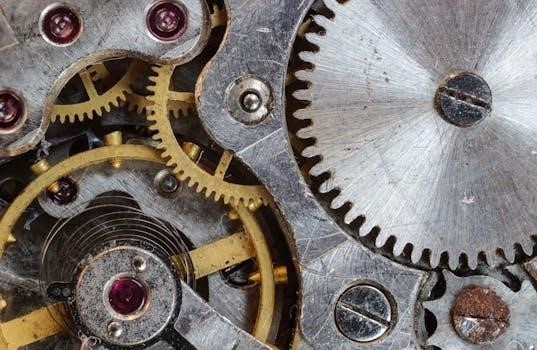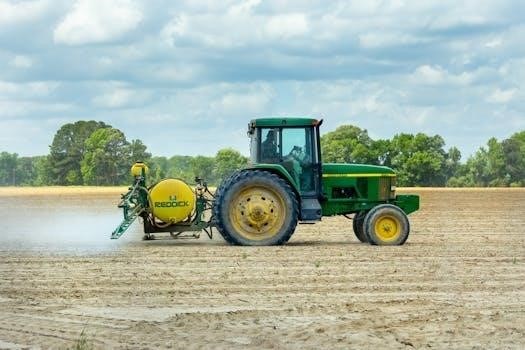The John Deere 7000 planter is a crucial piece of agricultural equipment, and maintaining it requires a reliable source for parts. This section will guide you through the essentials of identifying and acquiring the right components.
Understanding the Importance of the Parts Catalog
A comprehensive parts catalog, especially in PDF format, is an indispensable resource for any John Deere 7000 planter owner. It provides detailed diagrams, part numbers, and specifications essential for accurate identification and ordering. Using the catalog ensures that you purchase the correct components, maintaining the planter’s performance and avoiding costly mistakes. Whether you’re replacing a worn-out disc opener or a specific meter part, this catalog is your key to efficient repairs. It allows for proactive maintenance, reducing downtime during critical planting seasons. The catalog serves as a direct link to understanding the planter’s intricate design, ultimately saving time and money.

Key Components and Their Functions
Understanding the core parts of your John Deere 7000 planter is vital for effective maintenance. This section covers essential components and their roles in planting accuracy and efficiency.
Disc Openers and Scraper Blades
Disc openers are crucial for creating the seed furrow, ensuring proper seed placement at the correct depth. These parts are designed to cut through soil and residue, preparing the ground for planting. Scraper blades work alongside the disc openers, preventing soil buildup and maintaining a clean cutting edge. Regular inspection and replacement of these components are necessary for optimum planter performance. Worn or damaged disc openers can lead to uneven seed placement, while ineffective scraper blades can cause issues with depth control and furrow formation. Keeping them in good condition is crucial for a successful planting operation. Look for high-quality replacements to ensure they can handle tough field conditions.
Gauge Wheels and Their Role
Gauge wheels on a John Deere 7000 planter play a vital role in controlling planting depth. These wheels run adjacent to the disc openers, ensuring that the planter maintains a consistent depth across the field. They work by pressing against the soil and preventing the disc openers from cutting too deeply. Proper adjustment and maintenance of gauge wheels are crucial for even seed emergence and optimal plant stands. Worn or improperly adjusted gauge wheels can lead to variations in planting depth, affecting the overall yield. Using the parts catalog, you can find the correct gauge wheels for your planter. Look for durable options that can withstand the rigors of field work.
Seed Tubes and Accurate Placement
Seed tubes are a critical part of the John Deere 7000 planter, responsible for guiding seeds from the metering unit to the furrow. These tubes ensure that seeds are placed accurately and consistently, preventing skips or doubles. The condition of the seed tubes directly impacts the precision of seed placement. Worn or cracked tubes can lead to irregular spacing and depth, negatively affecting germination and plant development. When replacing seed tubes, it’s essential to consult the parts catalog to find the correct specifications. Proper selection and maintenance of seed tubes contribute significantly to achieving optimal planting results. Consider options that offer durability and longevity.

Where to Find John Deere 7000 Planter Parts
Locating the correct parts for your John Deere 7000 planter is essential. This section will explore various avenues, from online retailers to salvaged options, for finding the necessary components.
Online Retailers Specializing in Ag Parts
Numerous online retailers cater specifically to agricultural parts, offering a wide selection of John Deere 7000 planter components. These platforms often provide detailed catalogs, allowing users to easily identify the parts they need. Sites like All States Ag Parts, Sloan Express, and Worthington Ag Parts are popular choices, offering both new and used parts with varying warranty options. These retailers also often provide customer support, which can assist in finding the correct part. Many offer fast and reliable shipping, ensuring that your planter is back in operation quickly. Online stores can also provide access to a wider inventory than local dealers, making them a valuable resource.
Salvaged and Used Parts Options
For those seeking cost-effective solutions, salvaged and used parts can be a viable option for the John Deere 7000 planter. Companies like All States Ag Parts and Worthington Ag Parts often dismantle older planters to offer a range of used components. These parts are typically more affordable than new ones, making them suitable for budget-conscious farmers. However, it’s crucial to thoroughly inspect used parts for wear and damage before purchasing. Salvaged parts may have a shorter lifespan, but they can be a practical choice when a quick fix is needed. Always verify the condition and compatibility with your planter model before making a purchase.

OEM vs. Aftermarket Parts
When sourcing parts, you’ll encounter both Original Equipment Manufacturer (OEM) and aftermarket options. Each has distinct advantages and disadvantages that should be considered for your John Deere 7000 planter.
Advantages of Original Equipment Manufacturer Parts
Opting for Original Equipment Manufacturer (OEM) parts for your John Deere 7000 planter offers several key advantages. OEM parts are manufactured by John Deere or their authorized suppliers, ensuring they meet the exact specifications and quality standards of the original components. This precision often translates to a better fit, improved performance, and enhanced durability. Using OEM parts can also help maintain the planter’s warranty and overall reliability. While they might come at a higher price point, the long-term benefits of using parts that are specifically designed for your machine can often outweigh the initial cost, minimizing downtime and ensuring consistent operation.
Benefits of Aftermarket Replacement Parts
Aftermarket replacement parts for the John Deere 7000 planter can provide a cost-effective alternative to OEM options. These parts are produced by third-party manufacturers and can often be found at a lower price point, making them appealing to budget-conscious farmers. Aftermarket parts can also offer a wider range of choices, with some manufacturers specializing in improved designs or materials that may even surpass the original specifications. This can be particularly beneficial for older machines where OEM parts may be difficult to source or are prohibitively expensive. However, it is crucial to carefully assess the quality and reputation of the aftermarket supplier before purchasing, to ensure the parts meet your needs.
Specific Parts and Their Availability
This section explores the availability of specific John Deere 7000 planter parts. We’ll delve into finger pick-up meter components and parallel linkage parts, offering insight into where to find them.
Finger Pick-up Meter Parts
The finger pick-up meter is a vital part of the John Deere 7000 planter, responsible for accurate seed singulation. These parts are essential for consistent planting and include components like the finger assembly, back plates, and related hardware. Availability for these parts can vary, with options ranging from OEM replacements to aftermarket alternatives, all designed to ensure the planter’s performance. You can find these parts from various suppliers specializing in agricultural components, including online retailers and salvage yards. Understanding the specific model and part number is crucial for accurate ordering, often requiring the use of a parts catalog for reference. Proper maintenance and timely replacement of worn parts is critical for the planter’s optimal performance.
Parallel Linkage and Scrapers
Parallel linkage components on the John Deere 7000 planter ensure consistent row unit depth, while scrapers play a key role in keeping the disc openers clean. These parts are critical for proper seed placement and preventing soil buildup which is necessary for optimal planting. Common replacement parts include bushings, pins, and the scraper blades themselves. Availability of these components is generally good, with options from both original equipment manufacturers and aftermarket suppliers. When sourcing these parts, it’s important to ensure compatibility with the specific planter model. Using a parts catalog is essential for accurate ordering. Maintaining the parallel linkage and replacing worn scrapers are important for maintaining accurate planting depth.
Utilizing the Parts Catalog
A parts catalog is essential for identifying and ordering the correct components. This section will explain how to find and use the John Deere 7000 planter parts catalog effectively.
How to Access the PDF Catalog
To access the John Deere 7000 planter parts catalog in PDF format, start by visiting the official John Deere technical publications website. Once there, navigate to the “Equipment Publications” tab. In the provided search box, enter “7000” as the model number. This action should generate a dropdown list of equipment models. Select the specific “7000” model that appears. This selection will lead you to a page where you can locate the parts catalog in PDF format for download or viewing. This ensures you have the official resource for identifying specific parts.
Navigating the Catalog for Specific Parts
Once you have accessed the John Deere 7000 planter parts catalog, efficiently finding specific components is crucial. Begin by using the table of contents or index to locate the relevant section based on the part type or system. The catalog typically categorizes parts by function, such as seed metering, row units, or frame components. Carefully review the diagrams and illustrations, paying attention to part numbers and descriptions. If you know the specific part number, you can use the search or find feature to quickly locate it within the PDF document. This approach will expedite your search and ensure accuracy.

Maintenance and Repair Tips
Proper maintenance is key to the longevity of your John Deere 7000 planter. This section offers guidance on identifying wear items and troubleshooting common issues using the catalog.
Identifying Common Wear Items
Regular inspection of your John Deere 7000 planter is crucial for preventing breakdowns. Key areas to monitor include disc openers, which can wear down and affect seed placement; scraper blades, which need replacement to ensure proper cleaning of the discs; and gauge wheels, which should be checked for wear and proper alignment. Seed tubes are also prone to damage and should be inspected for cracks or blockages. Finger pick-up meter parts, parallel linkage components, and chains are also common wear items that require regular attention to maintain optimal planter performance. Consistent monitoring and timely replacement of these parts will maximize planting efficiency.
Troubleshooting Planter Issues
When operating a John Deere 7000 planter, you might encounter several issues that can affect planting accuracy. Common problems include uneven seed depth, which can be caused by worn gauge wheels or improperly adjusted disc openers. Seed skips or doubles might indicate issues with the finger pick-up meter or seed tubes. Poor seed placement can result from damaged parallel linkage or worn scrapers. If chains are loose or damaged, the planter’s drive system may not function correctly; Furthermore, issues with the closing wheels can lead to poor seed-to-soil contact. Regularly checking these components and addressing any issues promptly can ensure a successful planting season.